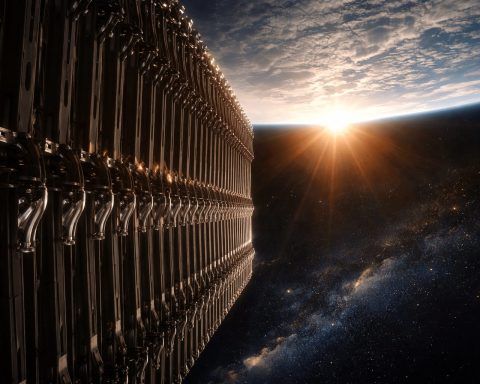Commercial Space Sector: Launches, Satellites & Space Tourism
- SpaceX’s Falcon 9 Reaches Reuse Milestone: SpaceX prepared to launch 24 Starlink internet satellites from Vandenberg SFB on Aug. 22, using a Falcon 9 booster flying its 17th mission [1] [2]. The veteran rocket (previously supporting Crew-7, CRS-29, and other missions) was set to land on a droneship after liftoff [3]. This underscores SpaceX’s rapid reuse pace and routine deployment of large satellite batches.
- Blue Origin Eyes Mars – and More Suborbital Flights: Jeff Bezos’ Blue Origin unveiled plans for a Mars Telecommunications Orbiter to relay data for future Red Planet missions [4]. The proposed “Blue Ring” spacecraft would use hybrid propulsion, large solar arrays, and deploy mini-satellites to ensure continuous broadband links for Mars landers/orbiters [5] [6]. Competing with concepts from Rocket Lab and Lockheed, Blue Origin’s pitch aligns with NASA’s late-2020s timeline to replace aging Mars relays [7]. In suborbital news, Blue Origin targeted Aug. 23 for its 35th New Shepard flight carrying over 40 microgravity research payloads to the edge of space [8]. This NS-23 mission (pending final checks) would bring the total New Shepard payloads flown to more than 200, as Blue Origin continues serving the space tourism and research market [9] [10].
- Firefly Expands Globally: U.S. startup Firefly Aerospace announced moves to launch from Asia and Europe. On Aug. 20, Japan’s Hokkaido Spaceport signed an agreement to study launching Firefly’s Alpha rockets from its commercial pad in Taiki [11]. “We look forward to exploring the opportunity to launch our Alpha rocket from Japan, which would allow us to serve the larger satellite industry in Asia and add resiliency for U.S. allies,” said Firefly VP Adam Oakes [12]. Firefly also inked a deal to build a pad at Sweden’s Esrange Space Center, after a U.S.–Sweden tech safeguards agreement cleared regulatory hurdles [13]. “Finalization of the [TSA] gets us one step closer to launching our Alpha rocket from Sweden,” Oakes noted [14]. Having flown six Alpha missions so far, Firefly aims to join Rocket Lab in operating launch sites on multiple continents [15] – a bid to tap regional markets and allies’ needs.
- Rocket Lab’s Rapid Cadence: Small-sat launcher Rocket Lab confirmed its 70th Electron mission, cheekily nicknamed “Live, Laugh, Launch,” is slated for this weekend (NET Aug. 23) from New Zealand [16]. The Electron will lift five satellites to orbit for an undisclosed commercial client [17]. Coming just weeks after its last launch, this milestone underscores one of the world’s most frequent launchers maintaining a high tempo while it also prepares a new Virginia pad for its medium-lift Neutron rocket [18]. The busy schedule reflects soaring demand for responsive launch services as megaconstellations and government smallsats proliferate [19].
Government Space Agencies: Programs, Missions & Collaboration
- NASA–ESA Climate Satellite Ready for Launch: Teams cheered the arrival of the Sentinel-6B oceanography satellite at Vandenberg Space Force Base, California [20]. Delivered on Aug. 18 after a trans-Atlantic voyage, Sentinel-6B will undergo final prep for a Falcon 9 launch in November [21]. This U.S.–European mission continues the vital task of tracking global sea-level rise started by its twin (Sentinel-6 Michael Freilich in 2020) [22]. Equipped with a precision radar altimeter, Sentinel-6B will map sea surface heights to improve climate models, coastal planning, and weather forecasting [23]. Its arrival extends a continuous NASA/ESA ocean-monitoring partnership dating back to 1992 [24].
- Japan Joins Asteroid Deflection Mission: In a boost for planetary defense, JAXA (Japan) announced plans to join ESA’s “Rendezvous with Apophis” (Ramses) mission [25]. Tokyo confirmed Japan will contribute hardware and a launch vehicle for the Apophis probe, which will rendezvous with the 340 m asteroid Apophis during its extremely close 2029 Earth flyby [26]. Under the emerging plan, JAXA will provide specialized cameras and solar panels, and launch the ESA probe on Japan’s new H3 rocket in April 2028 [27]. The probe aims to observe how Earth’s gravity affects Apophis – e.g. watching for landslides or surface shifts – turning the 2029 flyby into a “golden opportunity” to test asteroid deflection science [28]. While Apophis poses no impact threat, this international collaboration (to be finalized at ESA’s ministerial in November) underscores a globally shared commitment to guard Earth from potential asteroid hazards [29].
- India’s Ambitious Roadmap – Gaganyaan & Giant Rocket:ISRO outlined a packed agenda signaling India’s rising space ambitions. Chairman S. Somanath confirmed nine launches are planned for 2025, culminating in December’s maiden Gaganyaan test flight – an uncrewed mission carrying a humanoid robot (Vyommitra) to low Earth orbit [30]. “This year is declared as the Gaganyaan year… we will have the first uncrewed mission by December. A robot will go,” Somanath noted [31], underscoring the program’s significance as India’s leap into human spaceflight. Two more uncrewed tests will follow in 2026 before attempting to send Indian astronauts to orbit by 2027 [32]. In parallel, ISRO revealed progress on a next-generation super heavy-lift rocket dubbed “Surya”. The 92 m tall booster would loft 75 tonnes to LEO, a huge leap from India’s current capabilities [33]. “Today, we are conceiving a rocket to place 75,000 kg in low Earth orbit. The rocket is [the height] of a 40-storey building,” Somanath said, tracing ISRO’s evolution from early small launchers to this planned behemoth [34]. If realized, Surya would make India the fourth nation (after the US, Russia, China) to develop a rocket of that scale [35]. ISRO also noted plans to triple its active satellite fleet in coming years and upcoming launches (including a new NAVIC navigation satellite and even a 6.5-ton American comsat on India’s LVM3) [36] – signaling India’s intent to become a major player in both human spaceflight and heavy-payload launch services.
- Resupply Missions to the ISS: The conveyor belt of orbital logistics kept humming. NASA and SpaceX announced the 33rd Commercial Resupply Services mission (CRS-33) to the ISS, scheduled for launch on Aug. 24 [37]. The Dragon capsule will haul over 5,000 pounds of cargo, including crew supplies and science experiments ranging from bone-forming stem cells (to study bone loss) to materials for 3D-printing medical implants in microgravity [38]. Another experiment will deliver bioprinted human liver tissue to examine blood vessel growth in space [39]. Notably, this mission’s Dragon will also perform a reboost of the ISS’s orbit using a special kit in its trunk, demonstrating a new capability to maintain the station’s altitude [40]. In parallel, NASA and Northrop Grumman readied a Cygnus NG-19 cargo ship for launch no earlier than Aug. 22, carrying additional supplies and research to the ISS [41]. NASA also opened media accreditation for SpaceX Crew-8, a crewed mission slated for later this year [42]. Each of these routine missions feeds into the larger tapestry of keeping the ISS stocked and advancing research for future exploration.
Military & Defense Space: Secret Launches and Surveillance
- US Launches Secretive X-37B Spaceplane: The U.S. Space Force’s mysterious X-37B Orbital Test Vehicle took flight on its 8th mission (OTV-8) atop a SpaceX Falcon 9 from Kennedy Space Center late on Aug. 21 [43]. The reusable robotic spaceplane – which resembles a mini Space Shuttle – is carrying cutting-edge tech for in-orbit testing. Payloads include high-bandwidth laser communications systems and “the highest-performing quantum inertial sensor ever tested in space,” according to Space Force officials [44]. These devices promise new navigation methods for GPS-denied environments and could even aid future deep-space travel [45]. SpaceX successfully landed the Falcon’s booster at Cape Canaveral ~8½ minutes after liftoff [46], but at the military’s request the live webcast cut off before X-37B deployment to maintain secrecy [47]. Few details of the mission timeline or orbit were revealed – underscoring the vehicle’s hush-hush mandate to trial “black box” technologies. Still, officials heralded the flight’s importance. “OTV-8 exemplifies the X-37B’s status as the U.S. Space Force’s premier test platform for the critical space technologies of tomorrow,” said William Blauser, director of the Air Force Rapid Capabilities Office [48]. The mission highlights the growing synergy between commercial launch providers and military space objectives, as SpaceX’s reliability enables the Pentagon to quickly field new prototypes in orbit.
- Russia’s ‘Noah’s Ark’ Biosatellite & Spy Sat Launches: Russia had a busy week in orbit. On Aug. 20, Roscosmos successfully launched the long-awaited Bion-M No.2 research satellite aboard a Soyuz 2.1b rocket [49]. Nicknamed a “miniature mouse hotel”, this orbital bio-laboratory carries a menagerie of life: 75 mice and over 1,000 fruit flies, plus vials of microbes, plant seeds, and human cell cultures [50]. The critters will spend 30 days in microgravity before the capsule returns to Earth [51]. Scientists aim to study how spaceflight radiation and weightlessness affect biology at the molecular level – from tissue changes to long-term health impacts [52]. Interestingly, Bion-M2 also totes tubes of Moon dust simulant to see how lunar soil analogs are altered by a month in space [53]. Insights from this could inform future Moon base construction techniques [54]. It’s Russia’s first orbital bioscience mission since 2013, marking a revival of its space life-sciences program [55]. Then early Aug. 21, Russia’s Space Forces carried out a classified launch from Plesetsk Cosmodrome [56]. An Angara 1.2 rocket lofted an unnamed Kosmos military satellite into polar orbit – a trajectory typical for a reconnaissance platform that can cover all latitudes [57]. This was the second Angara 1.2 flight of 2025 as Russia gradually replaces its aging Soviet-era rockets with the modern Angara family [58]. Moscow released no payload details given the mission’s defense nature [59], but the timing underscores an international trend: multiple powers are bolstering their space-based surveillance networks. (Notably, the Russian launch occurred just hours before the U.S. flew its own secret spaceplane, underscoring how active and tactically important the orbital high ground is becoming for militaries around the globe.)
Science & Exploration: New Discoveries and ISS Experiments
- Hidden Moon Discovered Around Uranus: Astronomers using the James Webb Space Telescope (JWST) have spotted a previously unknown moon of Uranus [60]. The tiny moon, provisionally designated S/2025 U1, is estimated at only ~6 miles (10 km) across [61] [62] – so small it escaped detection even when Voyager 2 flew by Uranus in 1986. JWST’s sharp infrared vision caught the dim speck hiding between the orbits of Uranian moons Ophelia and Bianca [63]. “We found a previously unknown satellite of the ice giant,” said Dr. Maryame El Moutamid of Southwest Research Institute, who led the discovery team [64]. The diminutive moonlet, likely a dark ice/rock body, brings Uranus’ moon count to 29 [65]. Assuming it has similar reflectivity to its neighbors, the object’s mere 6-mile size explains why past telescopes missed it [66]. JWST detected it in long-exposure images taken in February, revealing a faint moving dot against Uranus’ glare [67]. The find hints at more undiscovered mini-moons around Uranus and offers insight into the dynamics of the planet’s ring-moon system [68]. The newfound moon orbits at the edge of Uranus’ inner rings, and the team is playfully debating naming options (keeping with Uranus’ tradition of Shakespearean character names) [69]. This result showcases JWST’s impressive reach for solar system science – even as it excels at distant galaxy and exoplanet observations – and gives planetary scientists a fascinating new target around the enigmatic ice giant [70].
- Hubble’s Dazzling New Galaxy Portrait: Not to be outdone, the aging Hubble Space Telescope delivered a stunning new image of a distant spiral galaxy. Released Aug. 20 as Hubble’s “Picture of the Week,” the photo shows galaxy NGC 2835 (35 million light-years away in Hydra) sprinkled with dozens of bright pink patches [71] [72]. By using a special filter for H-alpha light – the red glow of warm hydrogen gas – Hubble captured stellar nurseries glowing like rosy petals along the spiral arms [73]. These bubblegum-pink nebulae mark regions where massive young stars are igniting nearby gas clouds, as well as remnants of supernova explosions lighting up shells of gas [74]. Earlier images of NGC 2835 showed its blue star clusters and grand spiral structure, but the new H-alpha data makes the nebulae “pop” like flowers in bloom against the starry disk [75]. Astronomers plan to survey H-alpha across 19 nearby galaxies (including NGC 2835) to catalog over 50,000 nebulae, aiming to better understand how stars influence their environments from birth to death [76]. Even after 33 years in orbit, Hubble continues to produce scientific and visual marvels – a testament to its longevity and an exciting complement to JWST’s discoveries.
- DART Mission Yields New Impact Insights: NASA’s Double Asteroid Redirection Test (DART) made history in 2022 when it smashed into asteroid Dimorphos, proving asteroid deflection is possible. Now, nearly a year later, close-up images of the impact’s aftermath are sharpening our understanding of the event. Scientists from NASA and the Italian Space Agency (ASI) analyzed high-resolution photos from LICIACube – the small Italian probe that trailed DART and photographed the collision – and reported new results on Aug. 21 in the Planetary Science Journal [77]. The twin LICIACube images (taken ~2 minutes 40 seconds and ~3 minutes after impact) represent the most detailed observations of DART’s debris plume to date [78]. From these and other data, the team estimates DART’s impact blasted out debris equal to <0.5% of Dimorphos’s mass [79]. That might sound small, but “it was still 30,000 times greater than the mass of the spacecraft,” the researchers note [80]. In other words, the 570 kg DART probe displaced roughly 17,000 kg of asteroid material – an impressive bang-for-the-buck in momentum transfer. The images also reveal fine details of the ejecta pattern and help explain how DART managed to shorten Dimorphos’s orbital period by 33 minutes [81] [82]. These findings will inform the upcoming European Hera mission (launching 2026) which will visit Dimorphos to survey the crater and measure the deflection precisely. Together, DART, LICIACube, and Hera are advancing planetary defense from theoretical concept to proven technique [83].
- ISS Experiments Probe Health and Farming: A world away from these deep-space feats, astronauts aboard the International Space Station (ISS) continued work on microgravity science. The Expedition 73 crew is conducting studies on how spaceflight affects the human brain, balance, and immune system, using specialized tests and imaging of crew members before and after flight [84]. The goal is to better understand and counteract the neurological and physiological changes astronauts experience during long stays in orbit. The crew also tended to a space agriculture experiment, nurturing new plant seed pillows to test improved methods for growing food in microgravity [85]. Learning to reliably cultivate crops in space is crucial for future missions to the Moon and Mars. These routine ISS experiments, while less flashy than a moon discovery or rocket launch, are essential pieces of the puzzle for living and working in space long-term. Each result – from health data to fresh leafy greens grown aboard – helps pave the way for safer, sustainable human exploration beyond Earth.
Sources: Space.com [86] [87]; KEYT News [88] [89]; NASA (news releases & blogs) [90] [91] [92]; India Today [93] [94]; TS² Space News [95] [96] [97] [98]; NASA Science (Lonnie Shekhtman) [99]; NASA Science (DART findings) [100]; etc.
References
1. keyt.com, 2. keyt.com, 3. keyt.com, 4. ts2.tech, 5. ts2.tech, 6. ts2.tech, 7. ts2.tech, 8. ts2.tech, 9. ts2.tech, 10. ts2.tech, 11. ts2.tech, 12. ts2.tech, 13. ts2.tech, 14. ts2.tech, 15. ts2.tech, 16. ts2.tech, 17. ts2.tech, 18. ts2.tech, 19. ts2.tech, 20. ts2.tech, 21. ts2.tech, 22. ts2.tech, 23. ts2.tech, 24. ts2.tech, 25. ts2.tech, 26. ts2.tech, 27. ts2.tech, 28. ts2.tech, 29. ts2.tech, 30. ts2.tech, 31. ts2.tech, 32. ts2.tech, 33. ts2.tech, 34. ts2.tech, 35. ts2.tech, 36. ts2.tech, 37. www.nasa.gov, 38. www.nasa.gov, 39. www.nasa.gov, 40. www.nasa.gov, 41. ts2.tech, 42. ts2.tech, 43. www.space.com, 44. www.space.com, 45. www.space.com, 46. www.space.com, 47. www.space.com, 48. ts2.tech, 49. ts2.tech, 50. ts2.tech, 51. ts2.tech, 52. ts2.tech, 53. ts2.tech, 54. ts2.tech, 55. ts2.tech, 56. ts2.tech, 57. ts2.tech, 58. ts2.tech, 59. ts2.tech, 60. ts2.tech, 61. ts2.tech, 62. ts2.tech, 63. ts2.tech, 64. ts2.tech, 65. ts2.tech, 66. ts2.tech, 67. ts2.tech, 68. ts2.tech, 69. ts2.tech, 70. ts2.tech, 71. ts2.tech, 72. ts2.tech, 73. ts2.tech, 74. ts2.tech, 75. ts2.tech, 76. ts2.tech, 77. science.nasa.gov, 78. science.nasa.gov, 79. science.nasa.gov, 80. science.nasa.gov, 81. science.nasa.gov, 82. science.nasa.gov, 83. science.nasa.gov, 84. ts2.tech, 85. ts2.tech, 86. www.space.com, 87. www.space.com, 88. keyt.com, 89. keyt.com, 90. www.nasa.gov, 91. www.nasa.gov, 92. ts2.tech, 93. www.indiatoday.in, 94. www.indiatoday.in, 95. ts2.tech, 96. ts2.tech, 97. ts2.tech, 98. ts2.tech, 99. science.nasa.gov, 100. science.nasa.gov










